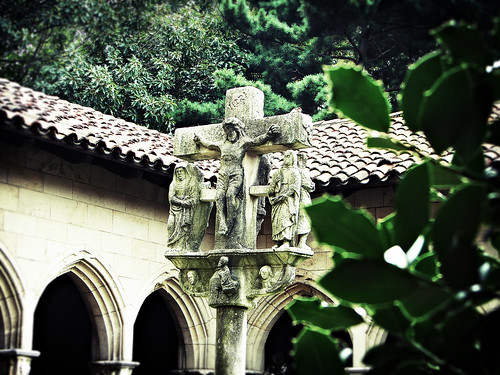- The cross at the center of the Cloister from Trie-en-Bigorre, at The Cloisters in New York City.
The following is a reflection on Philippians 2:1-13, the Epistle lesson appointed for September 25th, 2011 according to the New Revised Common Lectionary. (Proper 20, Year A) On this site there is also
• a reflection on the Gospel lesson for the same day [coming soon], and
• a version of the Prayers of the People, based on the lessons of the day.
The Christ Hymn, in the second chapter of Paul’s Epistle to the Philippians, is one of the greatest and most beautiful statements on the the nature of Christ, the immensity of the Incarnation, the agony of his death, and the current reign of Christ over things above and things below.
The hymn tells us that the Incarnation was an emptying of everything that Christ had. He poured it out. He went from God to slave.
It’s a radical demonstration of the reality that Jesus’ only sacrifice wasn’t on the cross. But, the manger was a sacrifice too.
Remember that in a few months time.
And then the hymn goes on to say that the Incarnation wasn’t the endpoint of Jesus’ emptying. He died. On a cross.
The hymn uses the word “death” twice. We aren’t supposed to miss that—even though the hymn doesn’t go into great detail here.
It doesn’t have to.
As Paul utilizes the hymn in this epistle, this is the section of the hymn that is meant to be instructive. We are to live out the same kind of self-emptying sacrifice in our births (baptism?), lives, and deaths.
We are, like Jesus, to be slaves of God—a title that Paul uses for himself often.
For any other person who ever walked the earth, a similar hymn about them would end there, with their death. But, for Christ, it’s only just past the midpoint of the hymn.
Following his death, he is exalted—one might presume this is the hymn speaking of Resurrection—and he is the object of worship, of all things that breathe, all things with a knee, and all things above and below. All creation worships and exalts him.
And that, just plain preaches.
But, since the crafters of the lectionary tacked on the next few lines, don’t miss them. They are beauties.
“For it is God who is at work in you.”
This Jesus, who was “in the form of God” who humbled and emptied himself in his birth as a slave, and who was obedient unto death, and who lives and reigns over all creation…is at work in YOU.
This is one of the great moments in the Scriptures where a grand, gorgeous, poetic, sweeping portrait is painted of a God–who is said to be in me.
No wonder Paul used this hymn. How can he, or we, keep from singing?
